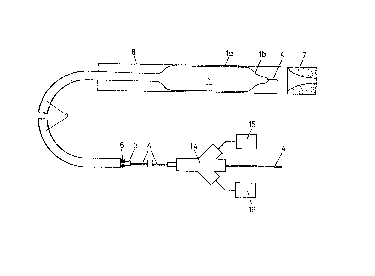Une partie des informations de ce site Web a été fournie par des sources externes. Le gouvernement du Canada n'assume aucune responsabilité concernant la précision, l'actualité ou la fiabilité des informations fournies par les sources externes. Les utilisateurs qui désirent employer cette information devraient consulter directement la source des informations. Le contenu fourni par les sources externes n'est pas assujetti aux exigences sur les langues officielles, la protection des renseignements personnels et l'accessibilité.
L'apparition de différences dans le texte et l'image des Revendications et de l'Abrégé dépend du moment auquel le document est publié. Les textes des Revendications et de l'Abrégé sont affichés :
| (12) Brevet: | (11) CA 2037404 |
|---|---|
| (54) Titre français: | CATHETER A FIBRE OPTIQUE POUR L'ANGIOPLASTIE |
| (54) Titre anglais: | ANGIOPLASTY LIGHT GUIDE CATHETER |
| Statut: | Périmé et au-delà du délai pour l’annulation |
| (51) Classification internationale des brevets (CIB): |
|
|---|---|
| (72) Inventeurs : |
|
| (73) Titulaires : |
|
| (71) Demandeurs : |
|
| (74) Agent: | SMART & BIGGAR LP |
| (74) Co-agent: | |
| (45) Délivré: | 1998-03-31 |
| (22) Date de dépôt: | 1991-03-01 |
| (41) Mise à la disponibilité du public: | 1991-09-06 |
| Requête d'examen: | 1991-03-01 |
| Licence disponible: | S.O. |
| Cédé au domaine public: | S.O. |
| (25) Langue des documents déposés: | Anglais |
| Traité de coopération en matière de brevets (PCT): | Non |
|---|
| (30) Données de priorité de la demande: | ||||||
|---|---|---|---|---|---|---|
|
Cathéter à ballonnet pour angioplastie dans lequel le ballonnet comporte sur ses parois une série de guides de lumière laser, qui sont incrustés dans les parois du ballonnet. Ainsi, les extrémités distales de ces derniers peuvent être déplacées radialement vers l'extérieur et vers l'intérieur en modifiant la pression à l'intérieur du ballonnet.
An angioplasty balloon catheter wherein the
balloon thereof has connectad to its wall a plurality
of laser light guides which are inlaid in the balloon
wall so that the distal ends of the liyht guides can be
moved radially outwardly and inwardly by changing
pressure within the balloon.
Note : Les revendications sont présentées dans la langue officielle dans laquelle elles ont été soumises.
Note : Les descriptions sont présentées dans la langue officielle dans laquelle elles ont été soumises.

2024-08-01 : Dans le cadre de la transition vers les Brevets de nouvelle génération (BNG), la base de données sur les brevets canadiens (BDBC) contient désormais un Historique d'événement plus détaillé, qui reproduit le Journal des événements de notre nouvelle solution interne.
Veuillez noter que les événements débutant par « Inactive : » se réfèrent à des événements qui ne sont plus utilisés dans notre nouvelle solution interne.
Pour une meilleure compréhension de l'état de la demande ou brevet qui figure sur cette page, la rubrique Mise en garde , et les descriptions de Brevet , Historique d'événement , Taxes périodiques et Historique des paiements devraient être consultées.
| Description | Date |
|---|---|
| Inactive : CIB enlevée | 2021-10-18 |
| Inactive : CIB attribuée | 2021-10-18 |
| Inactive : CIB expirée | 2013-01-01 |
| Inactive : CIB désactivée | 2011-07-26 |
| Inactive : CIB de MCD | 2006-03-11 |
| Inactive : CIB dérivée en 1re pos. est < | 2006-03-11 |
| Inactive : CIB de MCD | 2006-03-11 |
| Inactive : CIB de MCD | 2006-03-11 |
| Le délai pour l'annulation est expiré | 2003-03-03 |
| Lettre envoyée | 2002-03-01 |
| Inactive : TME en retard traitée | 2000-03-27 |
| Lettre envoyée | 2000-03-01 |
| Accordé par délivrance | 1998-03-31 |
| Inactive : Taxe finale reçue | 1997-11-28 |
| Préoctroi | 1997-11-28 |
| Lettre envoyée | 1997-10-27 |
| Un avis d'acceptation est envoyé | 1997-10-27 |
| Un avis d'acceptation est envoyé | 1997-10-27 |
| Inactive : Dem. traitée sur TS dès date d'ent. journal | 1997-10-23 |
| Inactive : Renseign. sur l'état - Complets dès date d'ent. journ. | 1997-10-23 |
| Inactive : CIB en 1re position | 1997-10-03 |
| Inactive : CIB enlevée | 1997-10-03 |
| Inactive : CIB attribuée | 1997-10-03 |
| Inactive : CIB enlevée | 1997-10-03 |
| Inactive : CIB attribuée | 1997-10-03 |
| Inactive : Approuvée aux fins d'acceptation (AFA) | 1997-09-11 |
| Demande publiée (accessible au public) | 1991-09-06 |
| Toutes les exigences pour l'examen - jugée conforme | 1991-03-01 |
| Exigences pour une requête d'examen - jugée conforme | 1991-03-01 |
Il n'y a pas d'historique d'abandonnement
Le dernier paiement a été reçu le 1997-11-05
Avis : Si le paiement en totalité n'a pas été reçu au plus tard à la date indiquée, une taxe supplémentaire peut être imposée, soit une des taxes suivantes :
Les taxes sur les brevets sont ajustées au 1er janvier de chaque année. Les montants ci-dessus sont les montants actuels s'ils sont reçus au plus tard le 31 décembre de l'année en cours.
Veuillez vous référer à la page web des
taxes sur les brevets
de l'OPIC pour voir tous les montants actuels des taxes.
| Type de taxes | Anniversaire | Échéance | Date payée |
|---|---|---|---|
| TM (demande, 7e anniv.) - générale | 07 | 1998-03-02 | 1997-11-05 |
| Taxe finale - générale | 1997-11-28 | ||
| TM (brevet, 8e anniv.) - générale | 1999-03-01 | 1999-02-23 | |
| Annulation de la péremption réputée | 2000-03-01 | 2000-03-27 | |
| TM (brevet, 9e anniv.) - générale | 2000-03-01 | 2000-03-27 | |
| TM (brevet, 10e anniv.) - générale | 2001-03-01 | 2001-02-19 |
Les titulaires actuels et antérieures au dossier sont affichés en ordre alphabétique.
| Titulaires actuels au dossier |
|---|
| SCHNEIDER (EUROPE) AG |
| Titulaires antérieures au dossier |
|---|
| EUGEN HOFMANN |